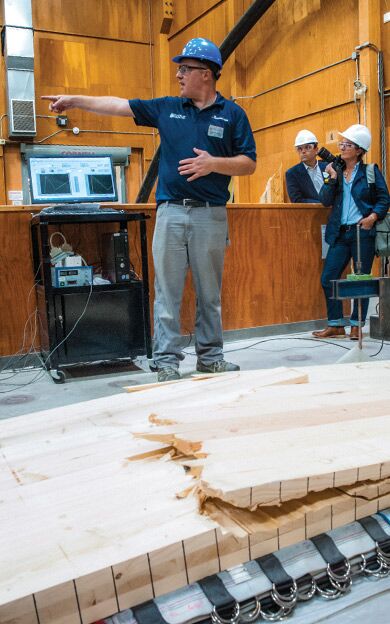Processing Your Payment
Please do not leave this page until complete. This can take a few moments.
- News
-
Editions
View Digital Editions
Biweekly Issues
- October 20, 2025
- October 6, 2025
- September 22, 2025
- September 8, 2025
- August 25, 2025
- August 11, 2025
- + More
Special Editions
- Lists
- Viewpoints
- Our Events
- Calendar
- Biz Marketplace
New mass timber initiative targets colleges and universities
 File photo / James McCarthy
Russell Edgar, wood composites manager at UMaine's Advanced Structures and Composites Center, demonstrates how cross-laminated timber products are tested for strength at the center.
File photo / James McCarthy
Russell Edgar, wood composites manager at UMaine's Advanced Structures and Composites Center, demonstrates how cross-laminated timber products are tested for strength at the center.
A new initiative that encourages colleges and universities to build with wood and find innovative ways to do it will boost Maine’s forest products industry, those involved say.
The initiative by the U.S. Endowment for Forestry and Communities and U.S. Forest Service offers grants to colleges and universities that look at ways to build with wood.
U.S. Sen. Angus King, I-Maine, in December, urged the federal government to offer incentives to colleges and universities to build with wood. The letter was signed by senators from both parties, including U.S. Sen. Susan Collins, R-Maine.
“Mass timber” means that the primary load-bearing structure of a building is a wood product.
“Mass timber construction projects offer an exciting opportunity for Maine’s forest products industry,” King and Collins said in a Tuesday news release. “With colleges and universities constantly building and expanding, mass timber projects can produce high-quality, environmentally friendly facilities that students, faculty, and local communities can enjoy. This grant program is an important step forward to encourage greater visibility for mass timber projects and to further innovation in the Maine woods.”
Maine’s forest industry contributes $8.5 billion to the state’s economy, and, while pulp mills have closed across the state in recent years, the state is 90% forested and the industry is looking for new ways to use the state’s timber. Those include innovative building materials, like cross-laminated timber.
Patrick Strauch, executive director of the Maine Forest Products Council, said the council has been promoting mass timber for several years.
“It’s also a big part of the FOR/Maine strategy to diversify markets, increase opportunities and draw attention to the innovative uses of wood,” he told Mainebiz on Wednesday. “We have a strong lumber industry in Maine and we know mass timber provides more opportunities for eco-friendly structures.”
Maine is “fortunate to have had the leadership of the University of Maine’s Advanced Structures and Composites Center in understanding the great potential of mass timber,” Strauch said. “Now Maine needs a demonstration project and this funding could make that happen.”
The initiative and Maine go together, said Lee Burnett, project director of Local Wood Works which provides resources for buildings and land owners to use local timber, including new ways of using it.
“Maine has the timber, the know-how and access to markets to become a big player in mass timber,” he told Mainebiz. “What we need right now are high-profile timber buildings to showcase possibilities and stimulate demand. Colleges are natural pioneers in this new way of building.”
'A triple win'
“Increased use of mass timber in construction is triple win,” said Steve Marshall, assistant director of cooperative forestry for the Forest Service.
Forests, rural economies and builders all benefit, he said in a March 19 news release announcing the initiative.
“Demand for sustainably sourced wood helps provide a market incentive for forest retention, management and stewardship activities that reduce the risk of high-severity wildfire,” he said.
“Colleges and universities are building at an incredible rate and we want to support their use of mass timber while educating the next generation of decision-makers about sustainable building solutions that support our forests.”
The U.S. Endowment for Forestry and Communities said the program goals are to:
- Break through barriers related to designing and constructing a cost competitive, code compliant mass timber building;
- Showcase the viability, application, "repeatability" and sustainability of mass timber construction across the country;
- Clearly illustrate the direct link between the use of mass timber components and the health and resiliency of U.S. forests and economic development opportunities in rural communities.
Mass timber demonstration projects are important, said Carlton Owen, president and CEO of the endowment.
“They increase understanding at the local permitting and approval agencies, as well as with design practitioners, developers and construction contractors, around the beauty and versatility of these products.”
He said demonstration projects will help speed adoption of recent code changes approved by the International Code Council that will allow mass timber applications in building up to 18 stories tall from the current six-story limit.
The dollar-for-dollar matching grants will support costs associated with pioneering the use of mass timber products and systems in buildings and open the door for more widespread adoption of innovative building materials. The money will help offset costs associated with review and planning for emerging building technology, whether in new construction or retrofit projects.
Higher education institutions, including universities, colleges and technical schools and their design and construction partners are eligible.
According to the request for proposals, which was issued March 19, preference will be given to proposals that turn their project into a case study for wide distribution, and those that have plans to build within the next 18 months. The submission deadline is May 31.
Boosting Maine timber
King’s December letter pointed to previous success of similar programs through the U.S. Department of Agriculture and the U.S. Forest Service “and highlight that the innovative solutions developed through a potential competition would benefit both the forest products industry and the environment,” a King news release at the time said.
“In 2015, the U.S. Forest Service and the USDA had tremendous success in bringing attention to the potential use of wood in tall buildings with the first U.S. Tall Wood Building Prize Competition,” the letter said. “We believe an award program utilizing an educational institution is an ideal next step to teach and demonstrate to the next generation of decision-makers, engineers, architects, planners and builders the benefits of mass timber.”
King and Collins have pushed for other boosts for forest products as well. The Farm Bill, which passed in December, included key provisions of the 2017 Timber Innovation Act, which King and Collins cosponsored.
The provisions encourage investment in manufacturing facilities needed to produce mass timber products domestically, provide incentives for the construction of buildings with wood and provide designers and code officials with the research and technical support they need to embrace the new construction technology.
Mass Timber development and commercialization were also key recommendations in the 2017 outlined Economic Development Assessment Team report, which spurred the creation of the University of Maine’s Maine Mass Timber Commercialization Center.
The report was originally requested in March 2016 by Collins and King, and it worked across federal and state agencies, industry sectors, and municipalities to create strategies for job growth and economic development in Maine’s rural communities.
Following the EDAT report, the Economic Development Administration awarded grant funding for the center at UMaine.
The center brings together forest industry partners, construction firms and other stakeholders to join to advance new forest technologies in Maine and accelerate the use of Maine-sourced timber and engineered wood composites in place of steel and concrete for larger construction projects.
Mainebiz web partners

The Giving Guide
The Giving Guide helps nonprofits have the opportunity to showcase and differentiate their organizations so that businesses better understand how they can contribute to a nonprofit’s mission and work.
Learn More
Work for ME
Work for ME is a workforce development tool to help Maine’s employers target Maine’s emerging workforce. Work for ME highlights each industry, its impact on Maine’s economy, the jobs available to entry-level workers, the training and education needed to get a career started.
Learn More
Groundbreaking Maine
Whether you’re a developer, financer, architect, or industry enthusiast, Groundbreaking Maine is crafted to be your go-to source for valuable insights in Maine’s real estate and construction community.
Learn more-
The Giving Guide
The Giving Guide helps nonprofits have the opportunity to showcase and differentiate their organizations so that businesses better understand how they can contribute to a nonprofit’s mission and work.
-
Work for ME
Work for ME is a workforce development tool to help Maine’s employers target Maine’s emerging workforce. Work for ME highlights each industry, its impact on Maine’s economy, the jobs available to entry-level workers, the training and education needed to get a career started.
-
Groundbreaking Maine
Whether you’re a developer, financer, architect, or industry enthusiast, Groundbreaking Maine is crafted to be your go-to source for valuable insights in Maine’s real estate and construction community.
ABOUT
NEW ENGLAND BUSINESS MEDIA SITES
No articles left
Get access now
In order to use this feature, we need some information from you. You can also login or register for a free account.
By clicking submit you are agreeing to our cookie usage and Privacy Policy
Already have an account? Login
Already have an account? Login
Want to create an account? Register
Get access now
In order to use this feature, we need some information from you. You can also login or register for a free account.
By clicking submit you are agreeing to our cookie usage and Privacy Policy
Already have an account? Login
Already have an account? Login
Want to create an account? Register







0 Comments